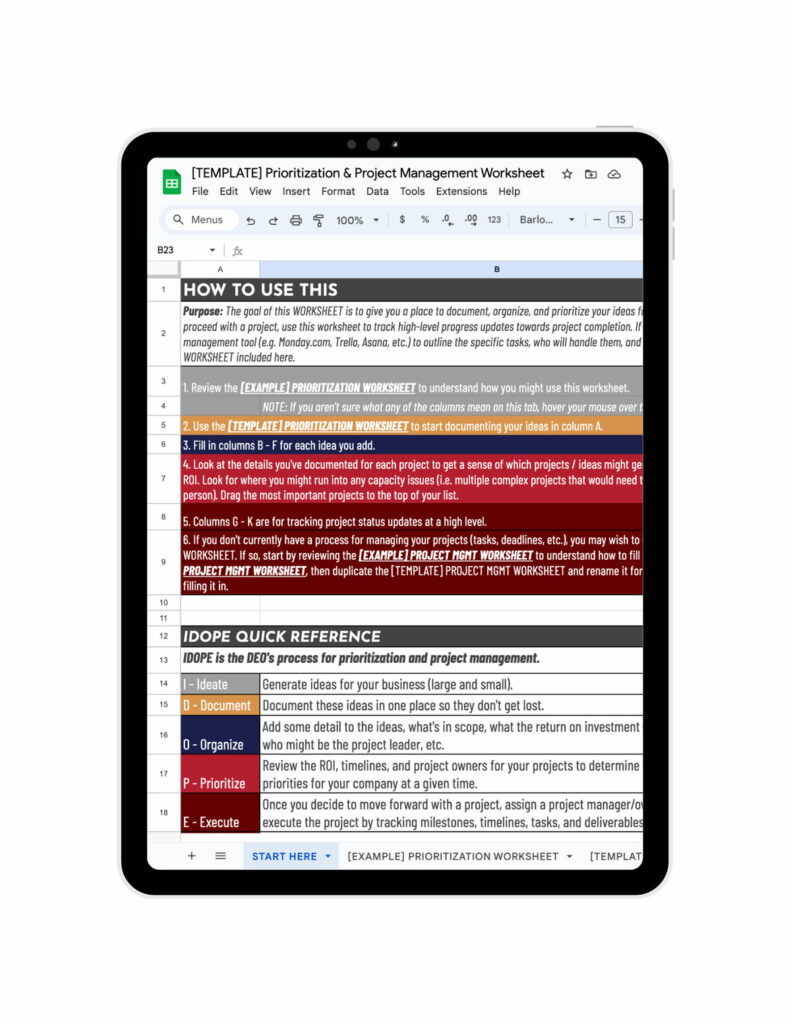Implementing project management systems to manage time more effectively as a leader.
Growing your own skills as a dental leader helps to move teams, practices, and the company as a whole forward.
Dental company leaders must be clear, concise, and confident in order to grow their business, and “a strong leader embodies the proper skills to ensure that the company runs smoothly, overseeing that daily responsibilities and long-term projects are well managed,” said Amber Nish.
So, how exactly do leaders guide teams with clarity and grow confidence in their professional skills? Amber Nish, a Marketing Coach at DEO, and Kyle Scott, a Project Manager for 70 plus doctors and offices within a DSO, shared their insights into how to prioritize your time as a team leader.
Developing leadership skills
As a leader, overseeing all the aspects of a dental business, including managing teams, day-to-day operations, and achieving company-wide goals can often be daunting. To address this and find clarity, implementing systems can help simplify the process of managing people and assist them in completing both daily responsibilities and ongoing projects.
Leaders can grow their confidence by implementing specific practices in the workplace such as aligning teams by setting clear priorities, holding staff accountable for completing what is most important now, not chasing distractions, and encouraging staff to achieve maximum performance in their responsibilities.
“Leaders should provide teams with clear priorities and systems to get tasks done. After delegating tasks and providing teams with the tools to accomplish them, trust that staff can handle them,” said Nish.
Providing teams with priorities and systems is known as project management. Project management is a critical skill to master in the workplace to best prioritize time as a leader. According to Nish, project management allows leaders to delegate tasks and successfully get ideas across to teams. Leaders that are skilled in project management are better able to align teams around what’s important and give staff clear directions so they can achieve actual results.
Benefits of project management
Leaders rely on the systems associated with project management to plan, best allocate resources, and give teams the tools they need to succeed.
Nish, Scott, and the DEO team came up with an analogy to convey the importance of project management with the example of three employees facing the task of swimming across a lake to the other side successfully. In this scenario, each employee is standing at the edge of the lakeshore trying to decide how to get across the water, and each individual has a different approach.
Person One rushes into the water, jumps in, and immediately starts paddling across the lake. This person doesn’t have a plan initially and doesn’t know how they’re going to complete the goal, but they trust themselves to figure it out in the moment.
Person Two approaches the challenge by pausing to research which swimming stroke would be best to get across the lake, what dangers or challenges there might be, and if there are any currents present in the lake. At this point, Person One is making more headway, while Person Two is still in the research phase.
While all of this is happening, Person Three begins the process of building a boat. Indeed, the person that takes the time and effort to build the boat will ultimately be the individual that completes the task first. In this example, the person that built the boat would be the one in a dental organization that would first gather the teams, tools, resources, and support necessary to complete the task through prior planning and research.
The lake scenario exemplifies why project management is so valuable — it provides teams with the systems they need to complete company tasks and goals.
“Often where leaders fail in project management is by not conducting the proper research first,” said Scott.
Project management can take workplace chaos and simplify it into a process — through planning, organization, motivating teams, and controlling resources, goals can be completed within a defined timeframe.
IDOPE
Project management itself requires step-by-step processes that leaders should follow to best implement and communicate systems with their dental staff.
“To organize, budget, and plan for projects, leaders should follow the IDOPE acronym with the following steps: Ideate, Document, Organize, Prioritize and Execute, as a process for conducting all project management planning,” said Scott and Nish.
First, leadership should write down all the ideas or goals they want to accomplish, document them, determine specific timelines, organize each project based on priority, and then begin executing them. The IDOPE acronym serves to simplify project management, allowing leaders to begin project planning systems no matter where they are currently at as a company.
Leaders should prioritize projects based on the greatest return on investment (ROI) for the company, instead of basing decisions on emotion, excitement, and feelings. Leadership teams should be able to say that each of the goals and priorities that are being worked toward have a measurable and significant impact on the company.
When determining project priority, leaders should make decisions that support doctors, clinical care staff, and clinical support staff first — as this will directly support a dental business’ primary customer, the patient. An example of a type of project could be identifying the need for a new associate (a company makes about 30-40% more revenue depending on if they hire a new associate). Another example is to invest in building career paths as a company to retain strong employees.
Once a company determines all the projects they want to accomplish and has gathered and discussed them as an executive team in a meeting, they can begin project management plans.
Prioritizing systems
The next step of project management is to choose the appropriate systems to help teams complete priorities. According to Nish, “there are three different ways to tackle a priority within a dental business, including strategic initiatives, projects, and tasks.”
The first type of a system is a strategic initiative. When determining a company’s strategic initiatives, leaders should first determine what challenges within the business needs to be solved, the definition of success, and the aspects of the problem that are not going to be solved with this specific system.
Strategic initiatives are composed of multiple projects. A strategic initiative is multi-department or company-wide, and complex. It takes more than an operational quarter to complete, and the “how” isn’t always clearly defined. Sometimes, it takes starting the project to realize that it is a strategic initiative and will require complexity and further projects. When approaching strategic initiatives, remember that leaders must break down all the ideas they have into systems that staff can follow and accomplish.
Next, a project is how teams execute a strategic initiative. Projects can also be thought of as the vehicle through which a strategic initiative is executed. The timeframe of completion for a project is between 30-90 days, with specified start and end dates. Projects also have a predetermined scope, budget, and timeframe, and are often comprised of multiple tasks.
Tasks are small, individual steps taken to accomplish a project. Tasks are transactional and tactical, can be done in two weeks or less, and can be assigned directly to an individual on a team. It is very easy to define what a completed task looks like.
“Leaders should make sure teams understand the difference between a strategic initiative, a project, and a task. Before assigning staff these responsibilities, explain the differences between each system and ensure teams fully understand each aspect,” said Scott.
For example, centralizing company scheduling is a strategic initiative, as it is multi-departmental and complex. Standardizing scheduling and standard operating procedures for all 7 practices is a project because it has a predetermined scope, and finally, scheduling meetings with a software vendor is a task, because it can be accomplished quickly and there is a clear path to get there.
For each priority, leaders should create a spreadsheet with the name of the project, the names of each of the tasks to get there, who the task is assigned to, what the due date of the task is, and a section on the spreadsheet for details, notes, or comments that everyone can edit.
Breaking priorities down into strategic initiatives, projects, and tasks provides staff with clear systems and language to ensure everyone on a team is aligned and doesn’t feel overwhelmed by their auxiliary responsibilities. Step-by-step systems serve to help leaders prioritize and effectively lead their teams to success.
| Strategic Initiative • At the company wide level (ex: launching denovos) because it’s multi-department • Takes more than a quarter to complete • Requires scoping • The “how” isn’t clearly defined • Is complex • Is comprised of multiple projects Project • Projects are the vehicle through which a Strategic Initiative is executed. • Timeframe is between 30-90 days • Has specified start and end dates, and finite resources. • Has a predetermined scope, budget, and timeframe. • Is comprised of multiple tasks. Task • Individual step to accomplish a project • Transactional & tactical • Can be done in 2 weeks or less • Can be assigned directly to an individual • Easy to identify what “done” looks like |
Amber Nish is a Marketing Coach at DEO, and through her position, has gained extensive experience in dental industry marketing. Nish’s previous experience in the marketing field was during her time as the Chief Marketing Officer for a dental group that she grew from seven locations to 30. Nish is always excited to share what she’s learned over the years as a marketing leader in her career and at DEO.








